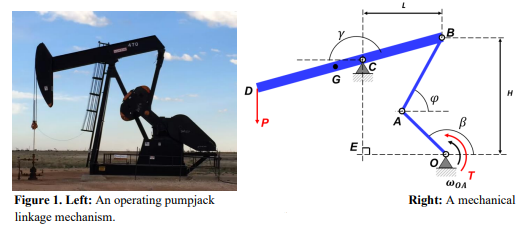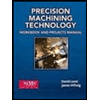Aim: To conduct a full kinematic analysis and calculate dynamic reaction forces in a linkage mechanism, calculate instantaneous torque, required to drive the mechanism and to present the results of the case study in a clear reporting format. Introduction: Figure 1 shows a pumpjack operating at an oil well. Its representation as a linkage is also shown in Figure 1. The pumpjack is driven by a motor attached to crank OA. A constant torque T is applied to the crank and the crank rotates at a constant angular velocity ???. A force P is applied vertically downwards at the end of the walking beam BD, which has its centre of mass at point G. To design the mechanism, a careful kinematic analysis of the mechanism needs to be conducted. To avoid mechanical failure and to provide adequate support to the mechanism, the engineer needs to analyse the reaction forces in the joints. Masses of links OA and AB are assumed to be smaller in comparison with the mass of BD and are ignored in the analysis. Magnitude of force P is equal to 10 kN and it is directed vertically upwards. Tasks: At the instant shown, perform the following tasks using the individual values of lengths OA, AB, BC, OE, CE, L, H, angle ?, angular velocity ???, mass ???, and moment of inertia ???. Length of the walking beam BD is equal to 2·BC. Distance CG from point C to the centre of mass of the walking beam is equal to ??/5. Velocity Analysis: - Present a clearly labelled velocity diagram; - Calculate the magnitude and direction of: > velocity of point A; > velocity of point B. - Calculate angular velocities of links AB and BC. Acceleration Analysis: - Present a clearly labelled acceleration diagram; - Calculate the magnitudes and directions of: > acceleration of points A and B; > angular acceleration of links AB and BC; > accelerations of points G. Dynamic Forces Analysis: - Present a clearly labelled free body diagram for each rod and the slider; - Calculate the magnitudes and directions of all reaction forces at the instant shown using accelerations obtained in acceleration analysis part; - Calculate the instantaneous torque, T, required to drive the mechanism at the instant shown. OA = 0.75m, AB = 4.00m, BC = 3.50m, BD = 7.00m, CG = 0.70m, OE = 2.40m, CE = 2.25m, L = 2.63m, H = 4.56m ? = 125 degrees, ??? = 3.8 rad/s, mOD = 2400kg, JBD = 2800kg m2 ? = 80.54 degrees, ? = 138.70 degrees, OC = 3.29m
Aim: To conduct a full kinematic analysis and calculate dynamic reaction forces in a linkage
of the case study in a clear reporting format.
Introduction: Figure 1 shows a pumpjack operating at an oil well. Its representation as a linkage is
also shown in Figure 1. The pumpjack is driven by a motor attached to crank OA. A constant torque
T is applied to the crank and the crank rotates at a constant angular velocity ???. A force P is applied
vertically downwards at the end of the walking beam BD, which has its centre of mass at point G.
To design the mechanism, a careful kinematic analysis of the mechanism needs to be
conducted. To avoid mechanical failure and to provide adequate support to the mechanism, the
engineer needs to analyse the reaction forces in the joints. Masses of links OA and AB are assumed
to be smaller in comparison with the mass of BD and are ignored in the analysis. Magnitude of force
P is equal to 10 kN and it is directed vertically upwards.
Tasks:
At the instant shown, perform the following tasks using the individual values of lengths OA, AB, BC,
OE, CE, L, H, angle ?, angular velocity ???, mass ???, and moment of inertia ???. Length of the
walking beam BD is equal to 2·BC. Distance CG from point C to the centre of mass of the walking
beam is equal to ??/5.
Velocity Analysis:
- Present a clearly labelled velocity diagram;
- Calculate the magnitude and direction of:
> velocity of point A;
> velocity of point B.
- Calculate angular velocities of links AB and BC.
Acceleration Analysis:
- Present a clearly labelled acceleration diagram;
- Calculate the magnitudes and directions of:
> acceleration of points A and B;
> angular acceleration of links AB and BC;
> accelerations of points G.
Dynamic Forces Analysis:
- Present a clearly labelled free body diagram for each rod and the slider;
- Calculate the magnitudes and directions of all reaction forces at the instant shown using
accelerations obtained in acceleration analysis part;
- Calculate the instantaneous torque, T, required to drive the mechanism at the instant
shown.
OA = 0.75m, AB = 4.00m, BC = 3.50m, BD = 7.00m, CG = 0.70m, OE = 2.40m, CE = 2.25m, L = 2.63m, H = 4.56m
? = 125 degrees, ??? = 3.8 rad/s, mOD = 2400kg, JBD = 2800kg m2
? = 80.54 degrees, ? = 138.70 degrees, OC = 3.29m

Trending now
This is a popular solution!
Step by step
Solved in 5 steps with 8 images




